a solo exhibition by Krystle Lemonias
Saturday, November 13, 2021 – Saturday, Jan 15, 2022
304 w Crest Ave, Tampa, FL 33603
the opening and closing dates of the exhibition will feature a performance by the artist, check our instagram for details
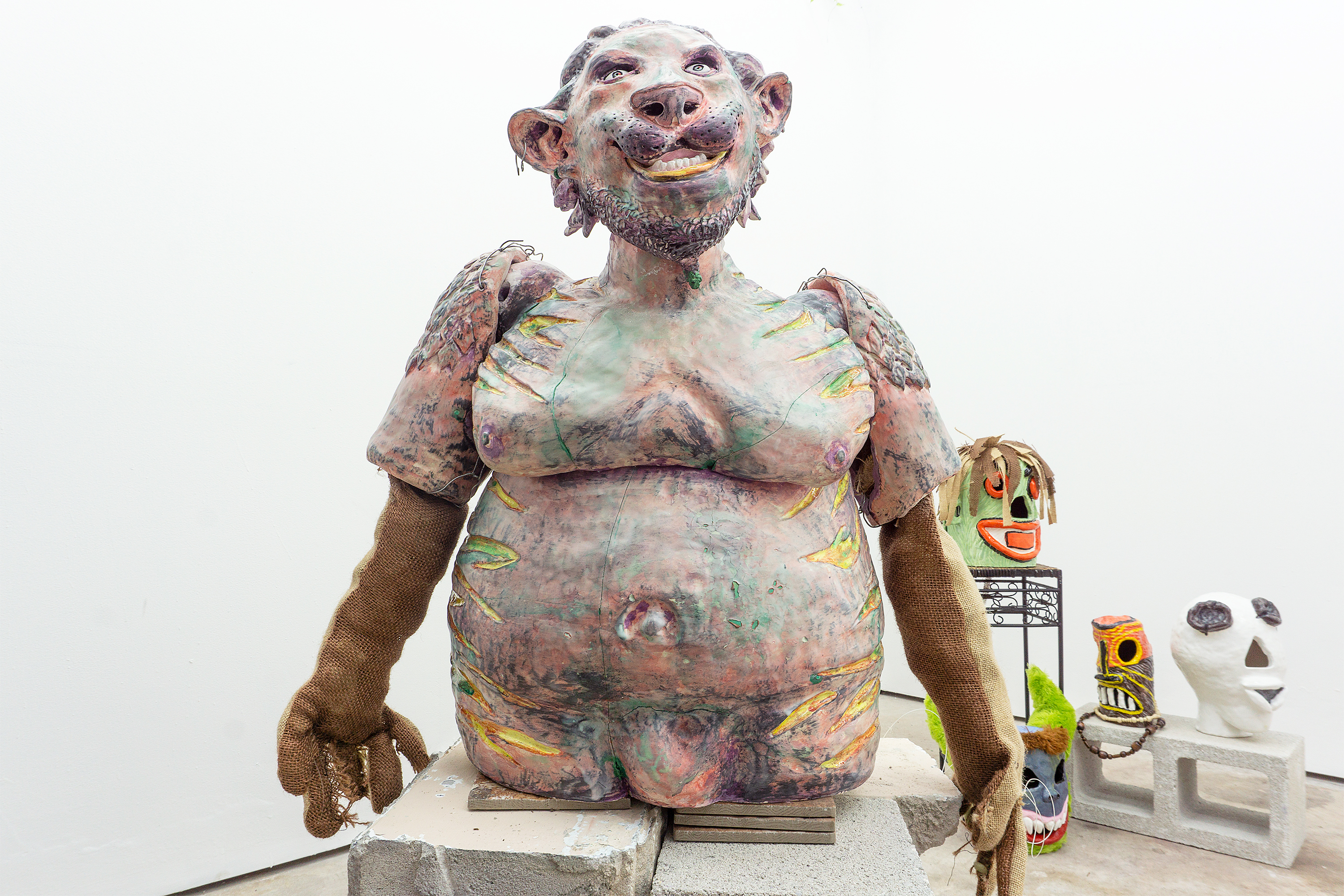
This work explores personal and political intersections of power that govern how people interact daily through an immigrant lens.
It creates an entry point to consider the impact larger systems have on people from colonized nations. Subjects are used to examine access, privilege, misuse, and obstruction to the status quo when one wields power.
Each piece reflects the complexity of being resilient through society’s exploitive structure then, using this understanding to get over and ahead for one’s self.
What is the cost of resilience?
Who really has the power?
KL, 2021
Coco Hunday is thrilled to present BUOY, IS JUST A COMEDY AH ERRORS, a solo exhibition of new works by Krystle Lemonias. On the occasion of the opening reception and closing reception (tentatively scheduled for January 13, 2022), the artist will perform in the exhibition space with handcrafted ceramic puppets. In addition, Coco Hunday will e-publish an interview between the artist and Art J Fraunfelter, MA candidate, University of South Florida.
On the occasion of Krystle’s exhibition, we will be publishing an interview between the artist and J. D’Oliveira Fraunfelter (MA candidate, University of South Florida) in April 2022, please scroll to the bottom to follow the conversation. Many thanks to both for their thoughts, time, labor, and care >


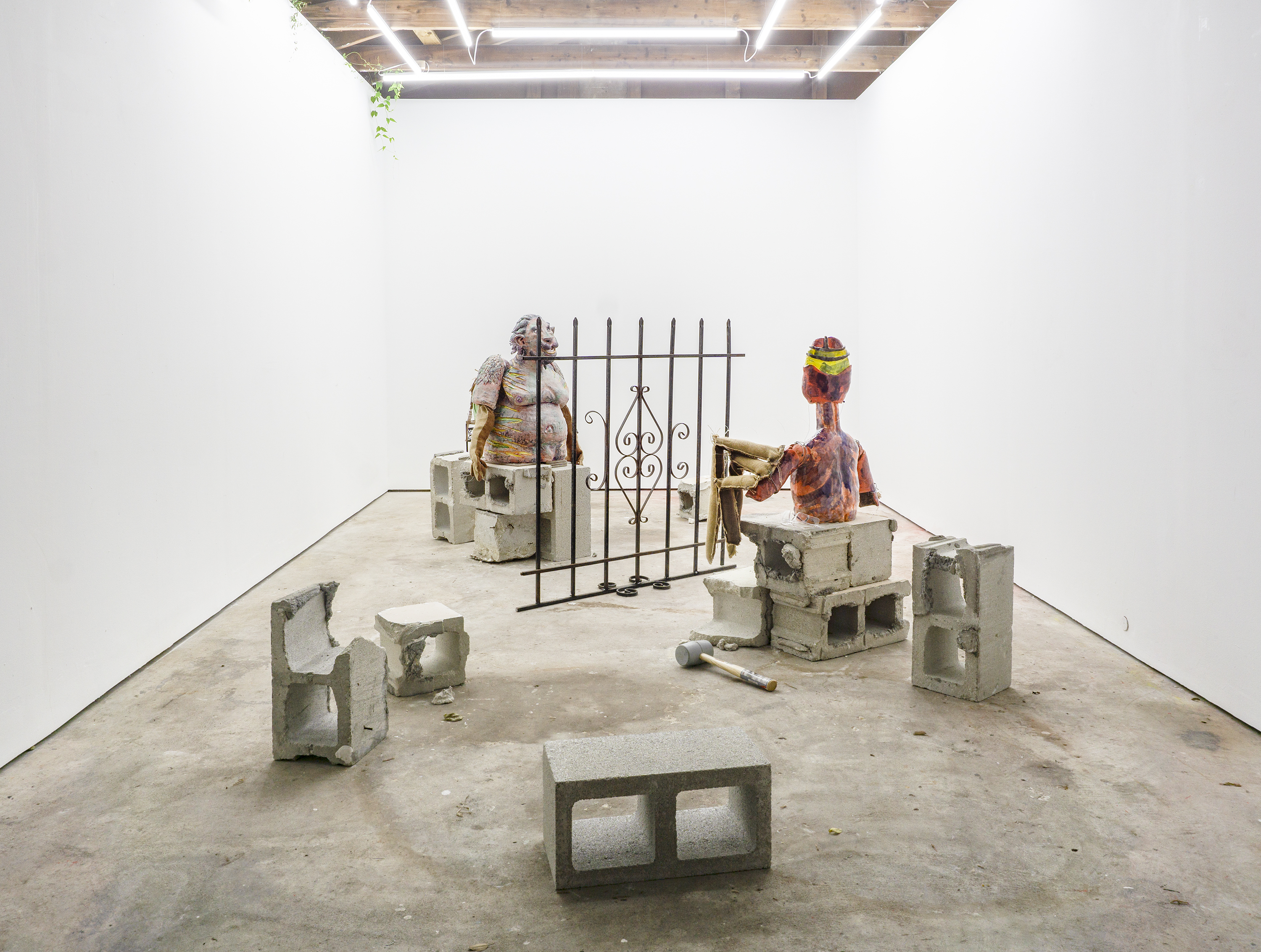
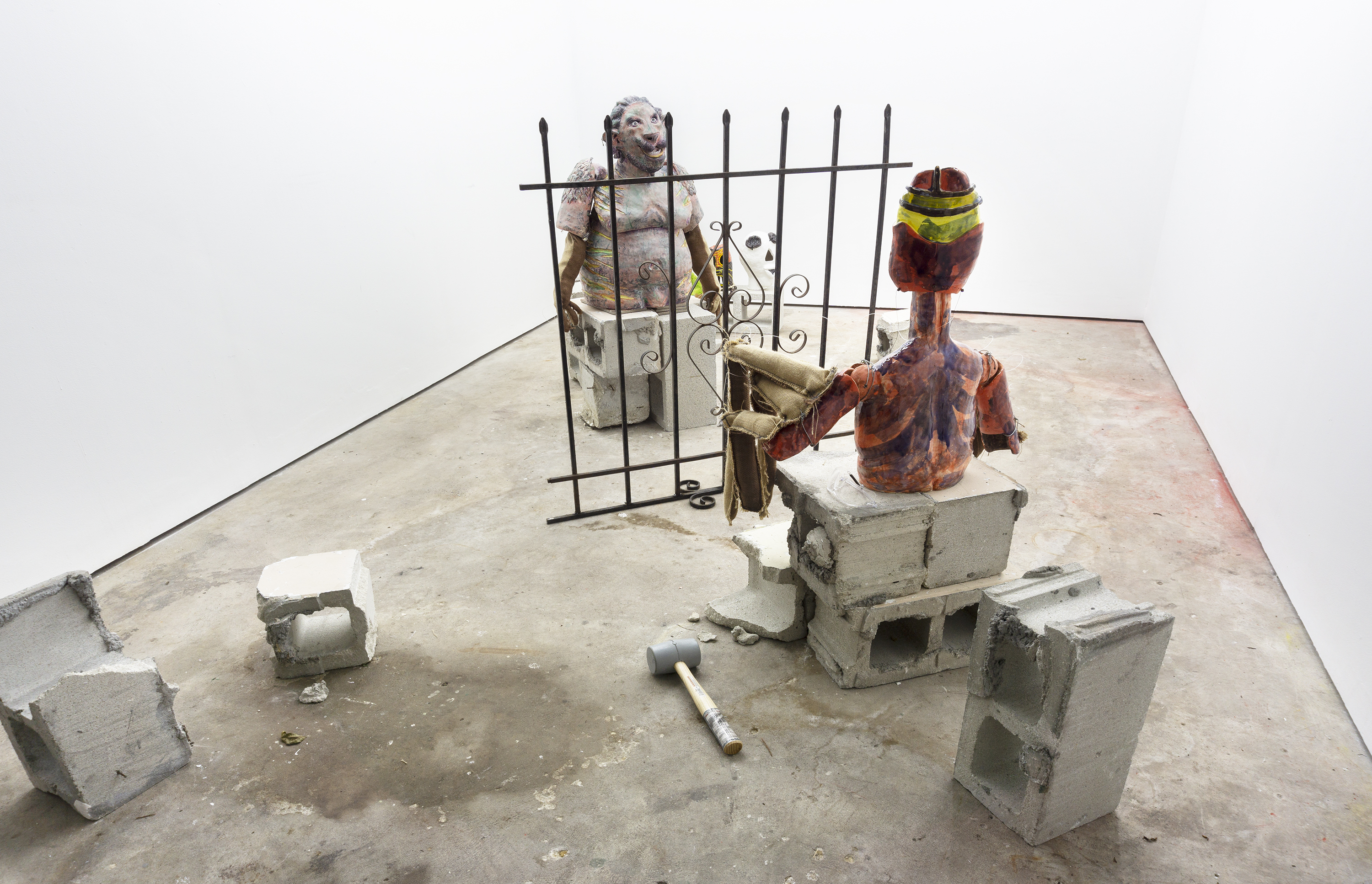
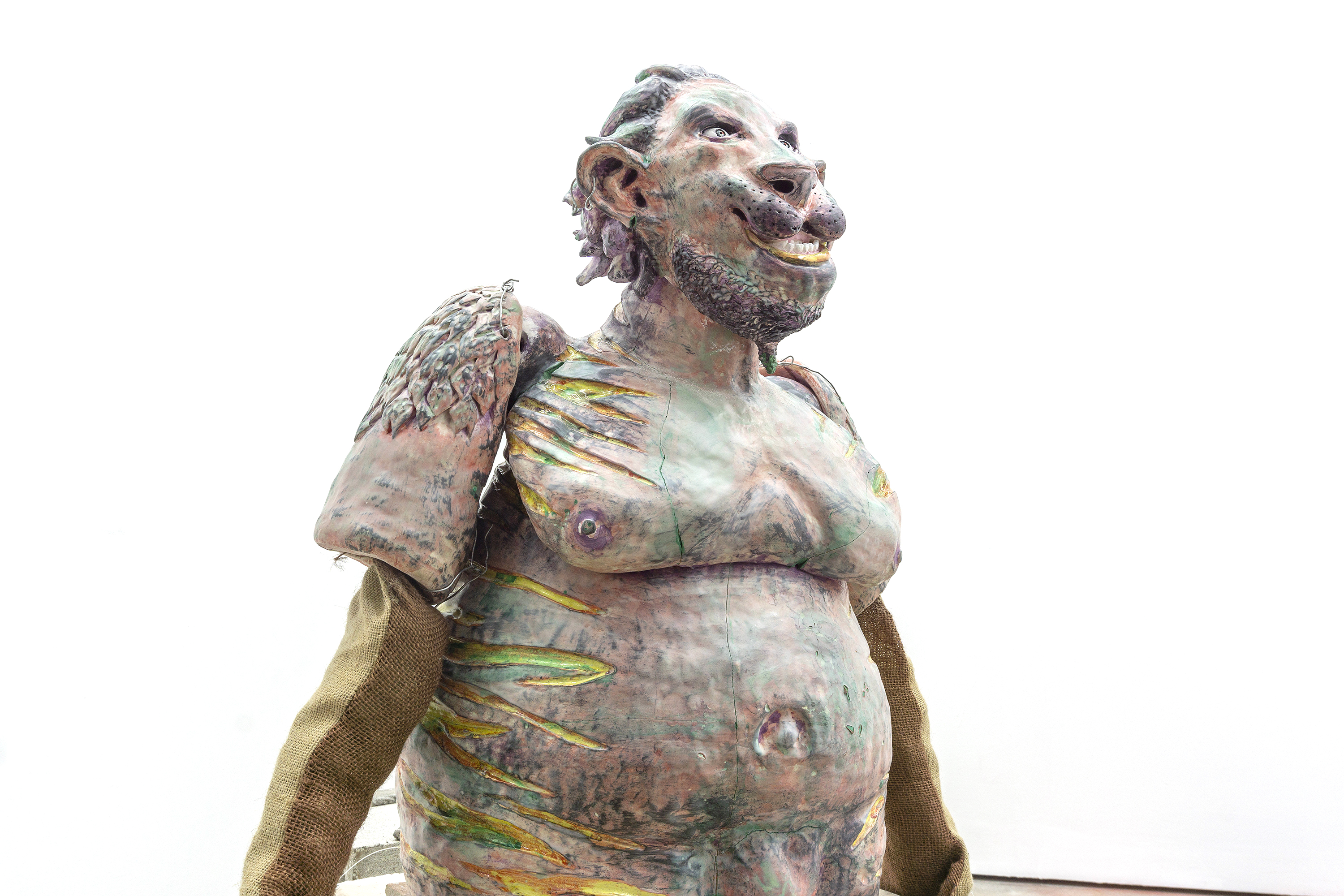
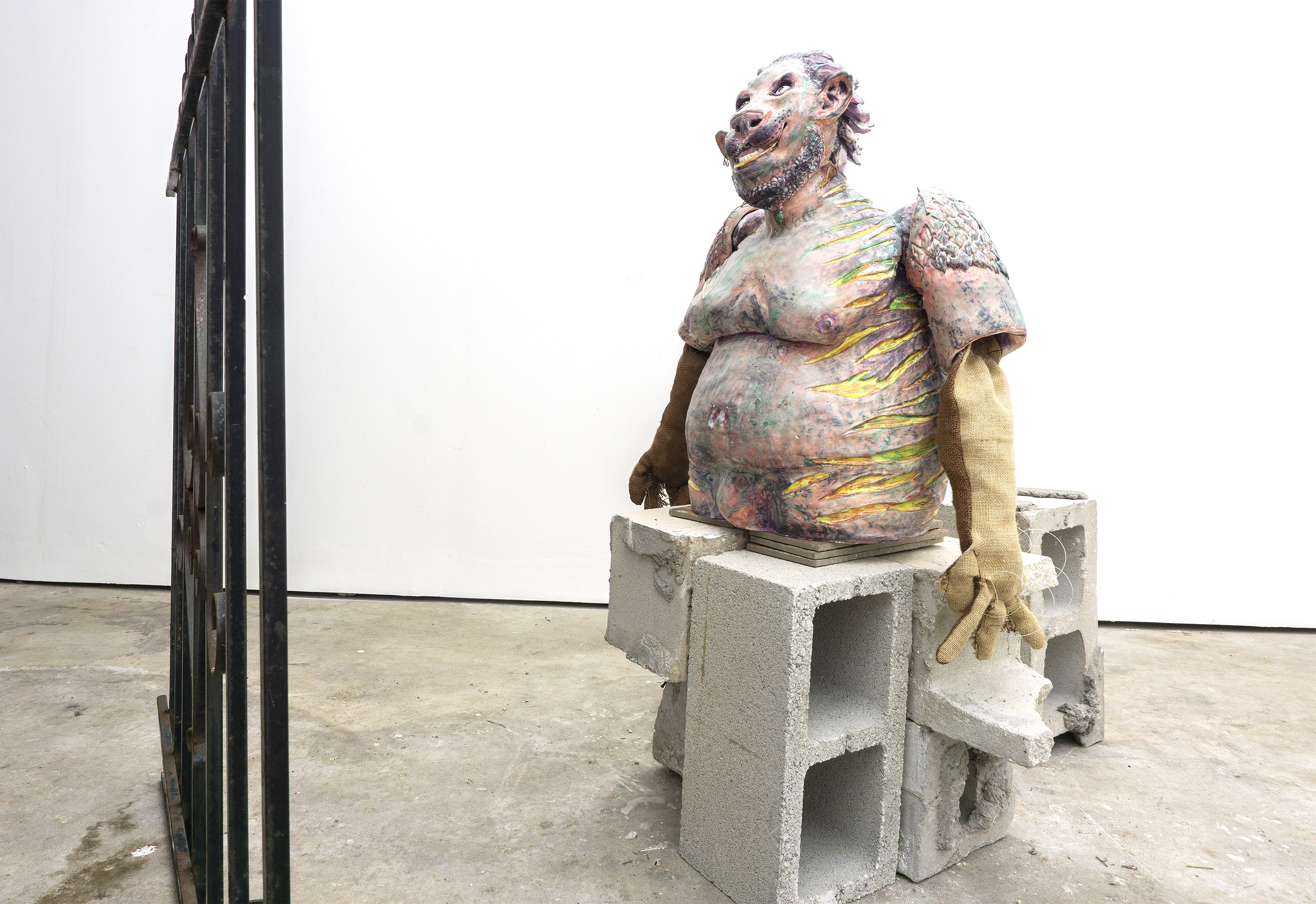

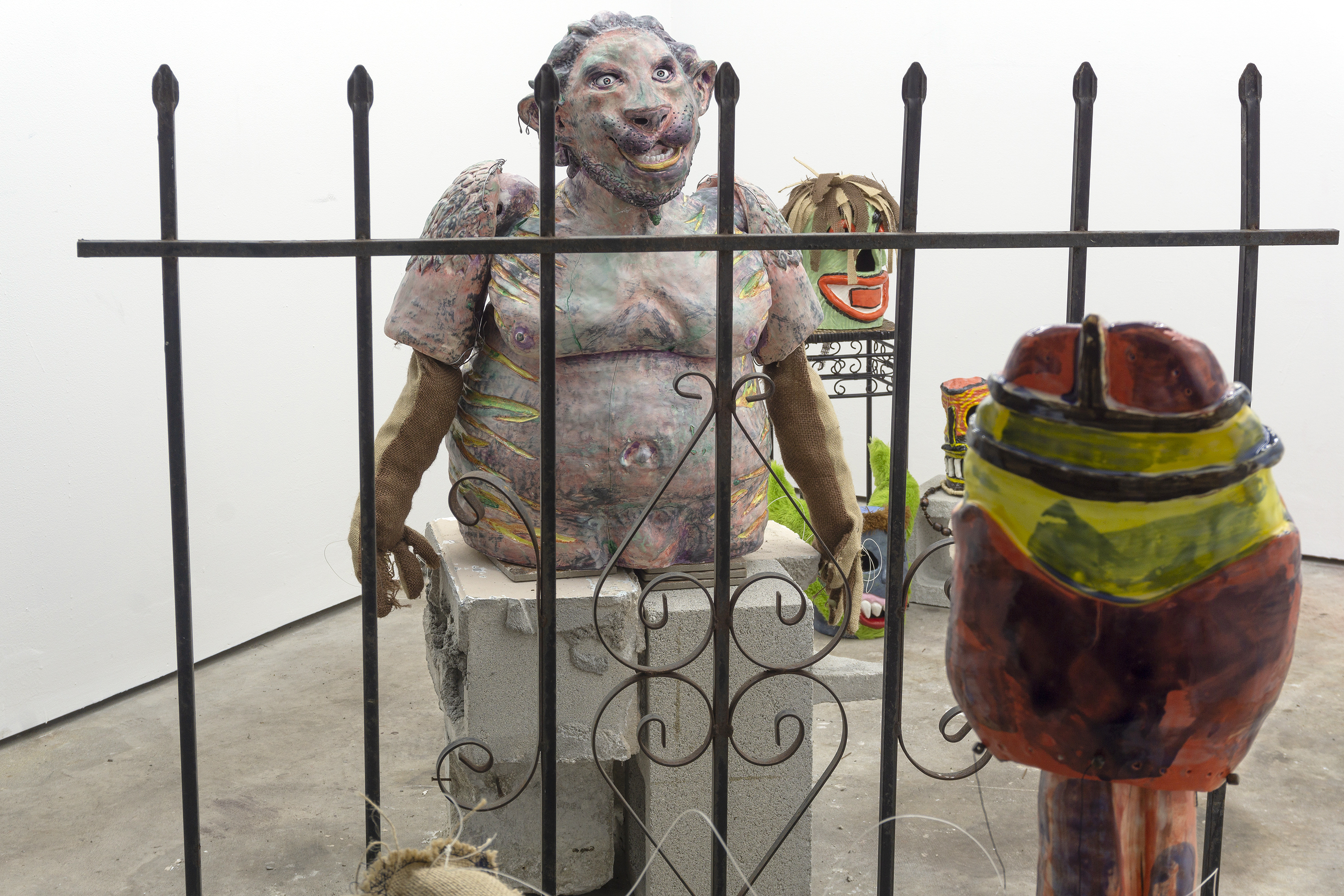


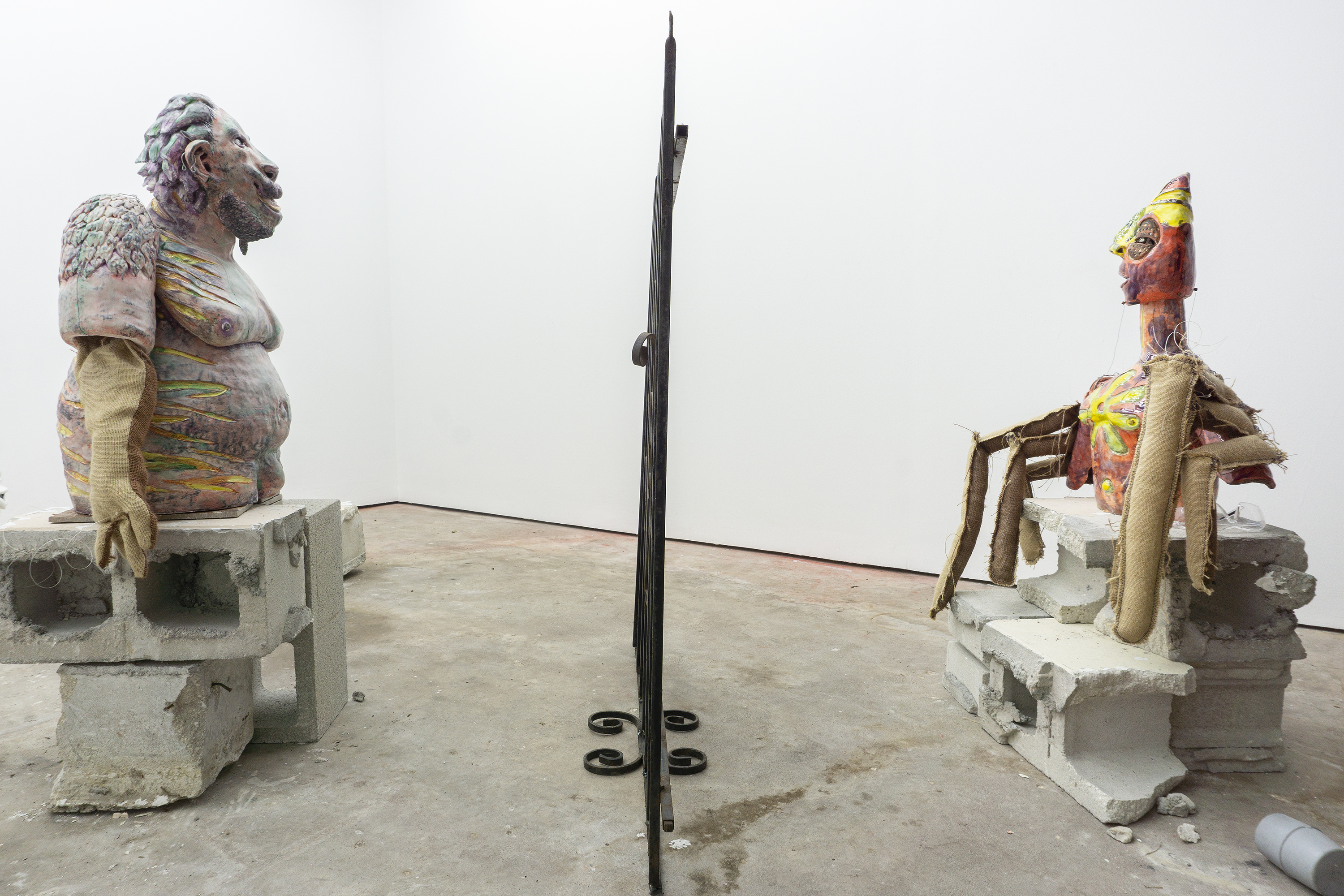

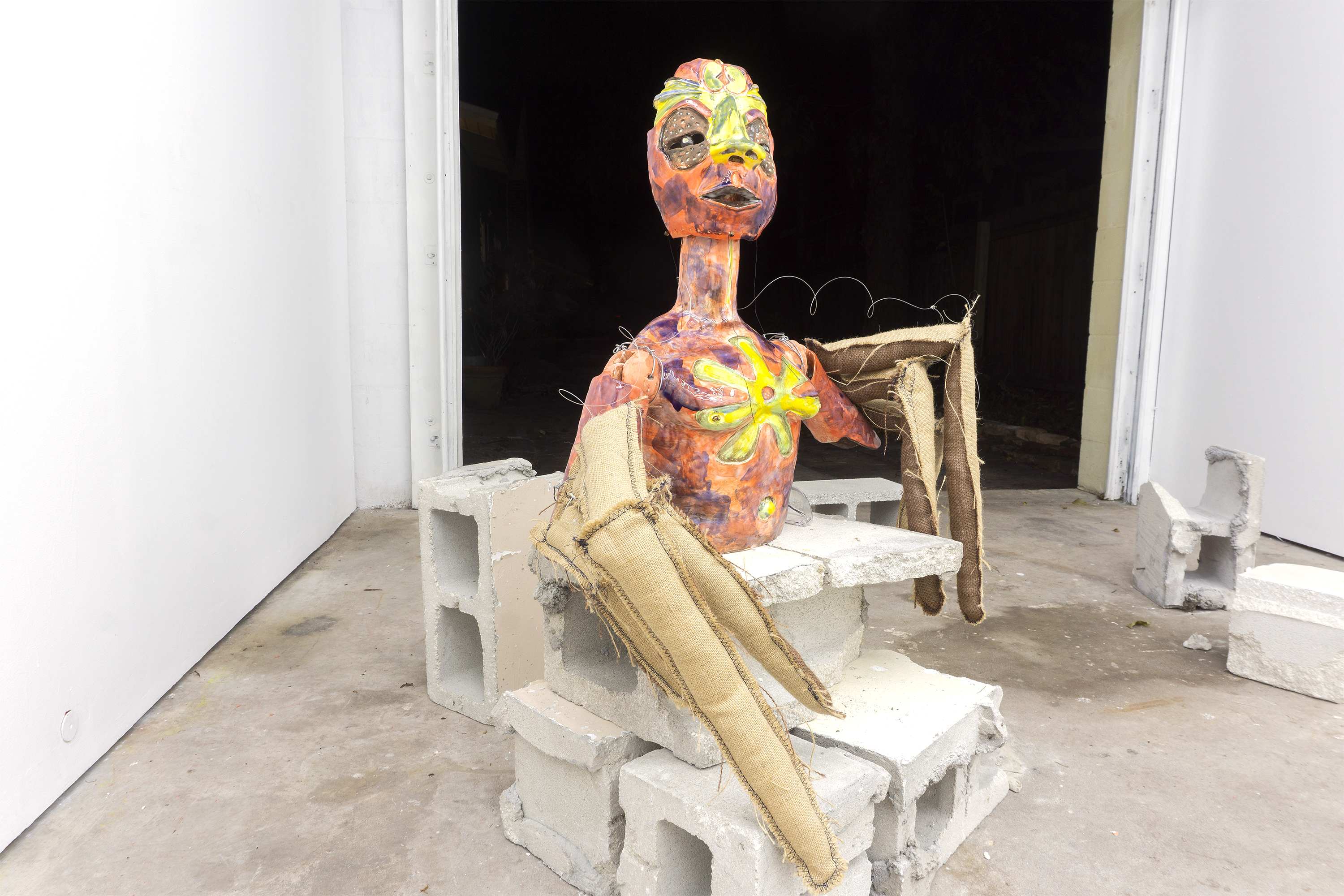


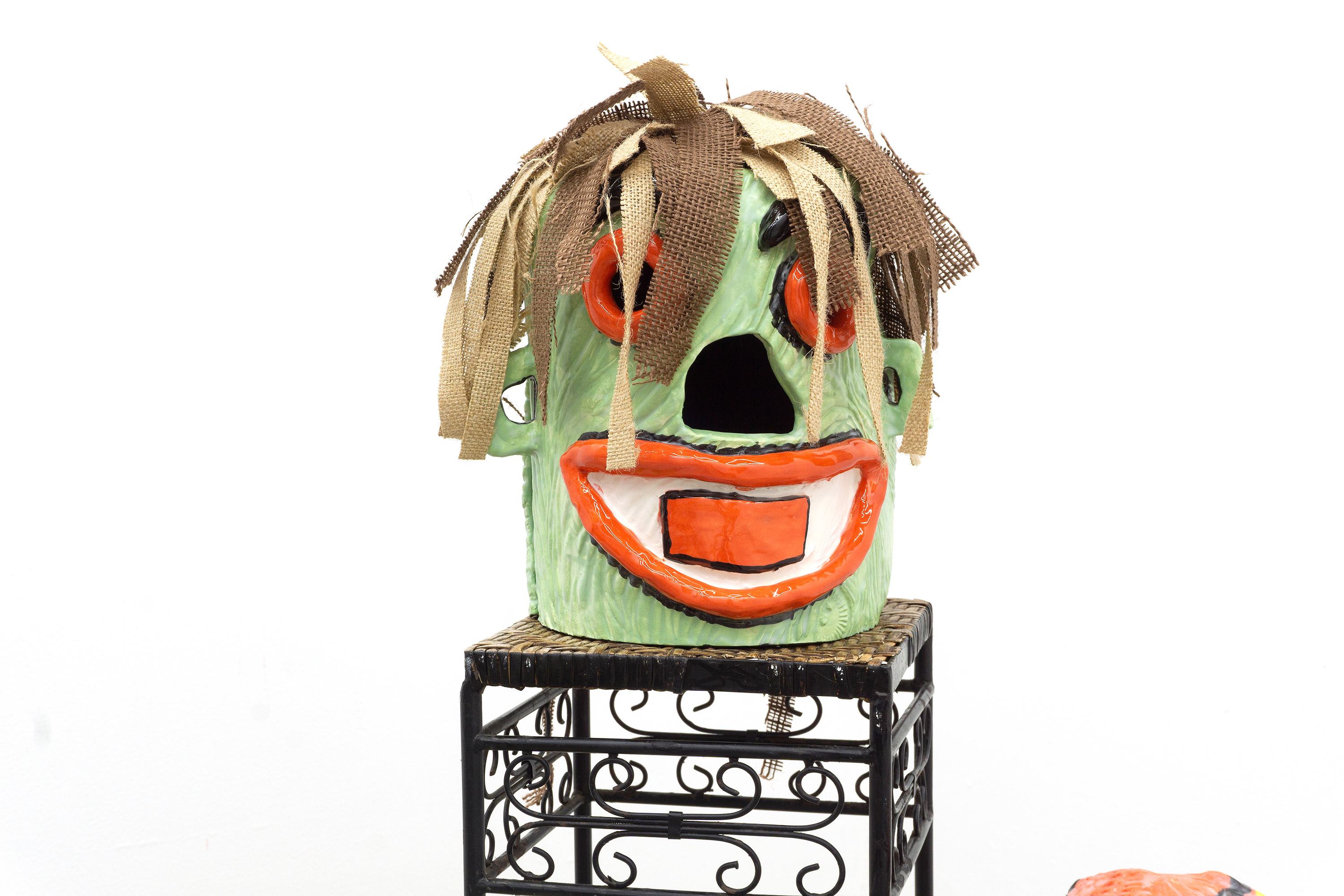

BIO:
Krystle Lemonias is recognized for her influences from the intersecting concepts of class, commodification, gender, economic inequity, citizenship, and labor rights. She believes immigrant Black communities contribute richly to the United States’ cultural diversity and the workforce despite the barriers faced. Her works explore primarily women’s domestic labor contributions that play an integral role in the function of our society and contemplate the domestic socialization passed on through generations to do these jobs.
She uses found materials, patios, printmaking methods, and iconography to stitch together these themes with personal narratives. Her works have been exhibited at Blum and Poe in the Show Me the Signs campaign for #sayhername and Make America What America Must Become at the Contemporary Art Center in New Orleans. She has also shown at the New York Academy of Art in the AXA Art Prize Exhibition in 2020, and at the International Print Center of New York in the New Prints: Umbra in 2019.
Lemonias was born in Jamaica, in 1989, and became of age in New Jersey. She acquired a BFA in printmaking from New Jersey City University in 2018. She is currently a Master’s in Fine Arts candidate at the University of South Florida.
#
On the occasion of Krystle’s exhibition, we are thrilled to publish this interview between the artist and J. D’Oliveira Fraunfelter (MA candidate, University of South Florida)…many thanks to both for their thoughts, time, labor, and care >
Krystle Lemonias interviewed by J. D’Oliveira Fraunfelter (MA candidate in Art History, University of South Florida), Spring 2022, on the occasion of her exhibition BUOY, IS JUS A COMEDY AH ERRORS at Coco Hunday (November 13, 2021 – January 15, 2022)
J: Stepping into Krystle’s studio, the walls are populated with colorful multimedia fabric works. A large work table encompasses the center of the room. Seated on the table is a portly, anthropomorphic clay puppet. They look worn, scarred, and somewhat mischievous. The puppet has a paternal presence: experienced, wise, with many stories to tell. My initial impressions of Krystle’s artwork situates her at the intersection of identity and experience; there are conditions: immigration, assimilation, syncretism, ancestral and present memory–that coalesce to form a whole.
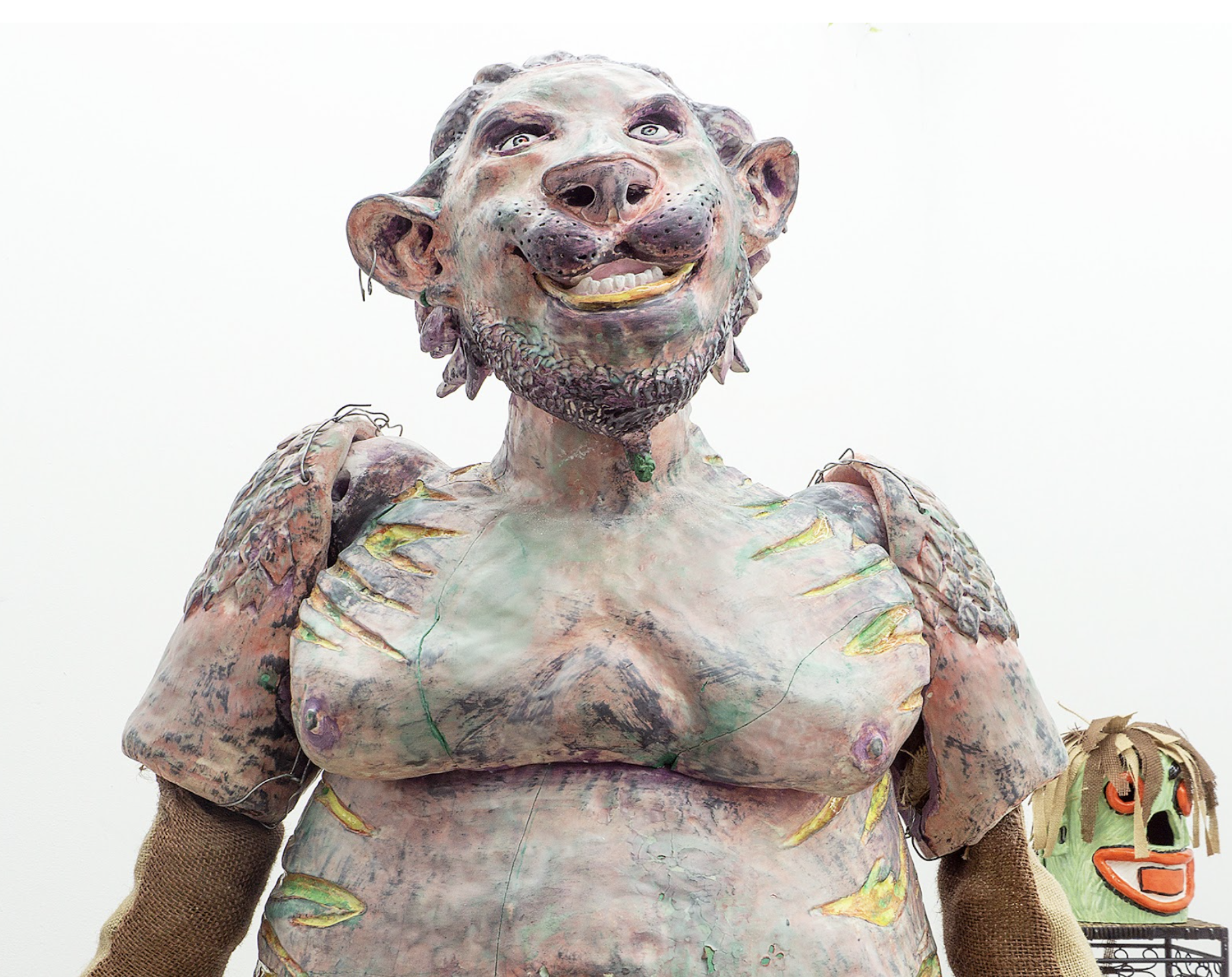 installation detail (Tiga), BUOY, IS JUS A COMEDY AH ERRORS at Coco Hunday, 2021-2022
installation detail (Tiga), BUOY, IS JUS A COMEDY AH ERRORS at Coco Hunday, 2021-2022
K: You can ask any question as you look at the work. Although I’m not showing any fabric work [for this exhibition] all the work kind of relate to each other. They have a constant theme of: how I use iconography, how I use patois, how I stitch–like literally, force materials together.
Krystle is working in the same vein as many communities of people who come from similar locations (Latin America and the Caribbean) where the impacts of European colonization, slavery, and indigenous identity compromise the socio-historical makeup of their society. As I take in the Adinkra Symbols that make up stark iconographic fields on her textile works (fig. 1&2), I think of Torres-García, Grafismo and his Constructivist artworks that drew upon pre-Columbian iconography to formulate an abstract language for contemporary Latin American artwork.
J: I was wondering about the idea of history-writing that we had briefly spoken about earlier. I wasn’t sure what your work actually was about, and how much of this is personal history. When I think of the idea of archiving narrative, the individual perspective is much more significant–we need to study the personal past to more accurately represent history. What I see is that you’re constructing a history, but using yourself as a beginning point of this novel timeline.
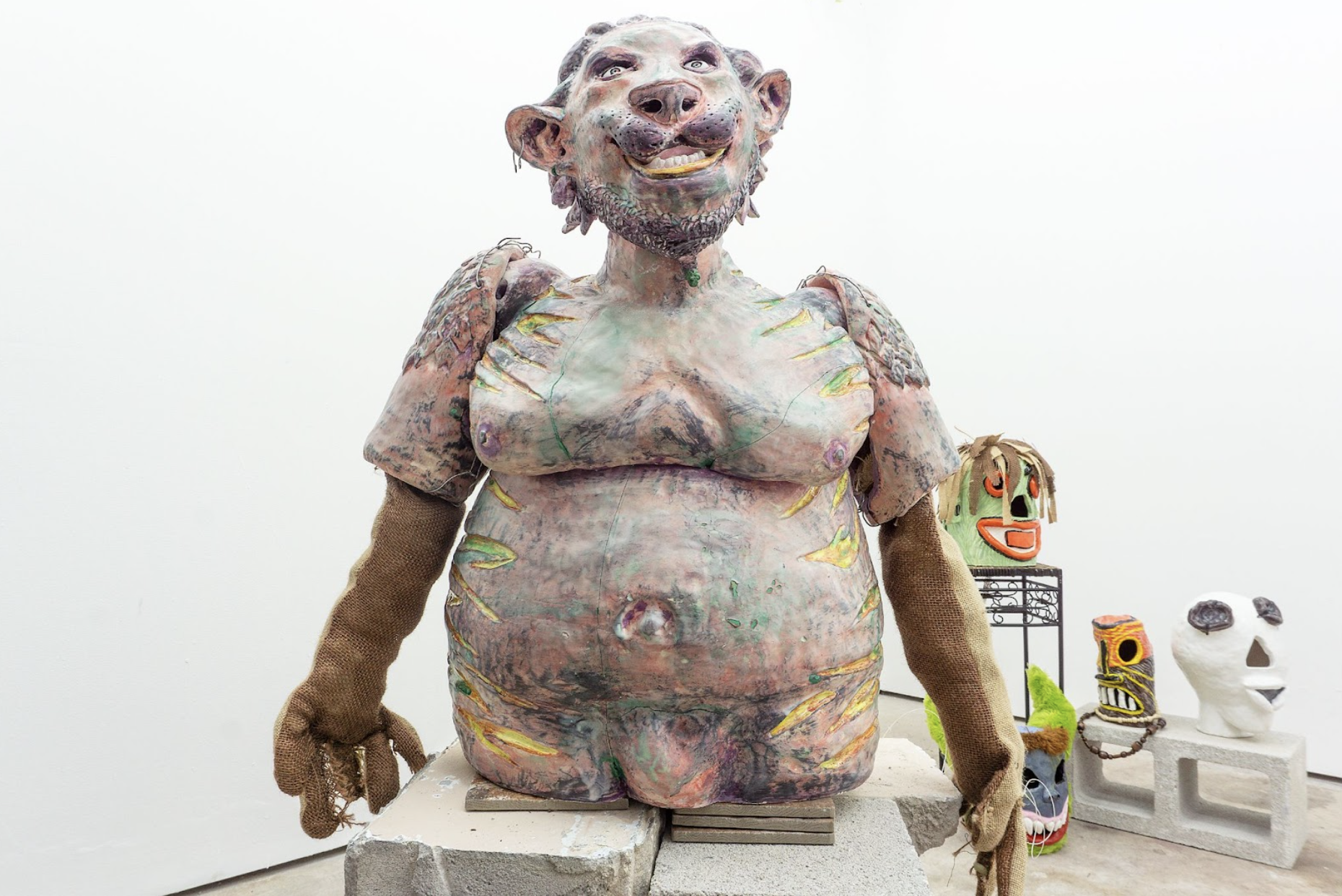
installation view, BUOY, IS JUS A COMEDY AH ERRORS at Coco Hunday, 2021-2022
K: That’s exactly what I’m doing so… [J: OK *Laughs*] In my work, the constant theme is labor. [J: Okay.] How do immigrants come to play a role in the labor in society? So, the fabric works (fig.1&2) are essentially representing domestic laborers. And then these puppets, I think of them as talking more about the paternal side of my family and the construction labor that they have done coming to America. I think about dirt. I think about the electrical work that they would do. I’m using these puppets as a way of caring. But then also working through these emotions that they have packed away for so long, and not dealt with.
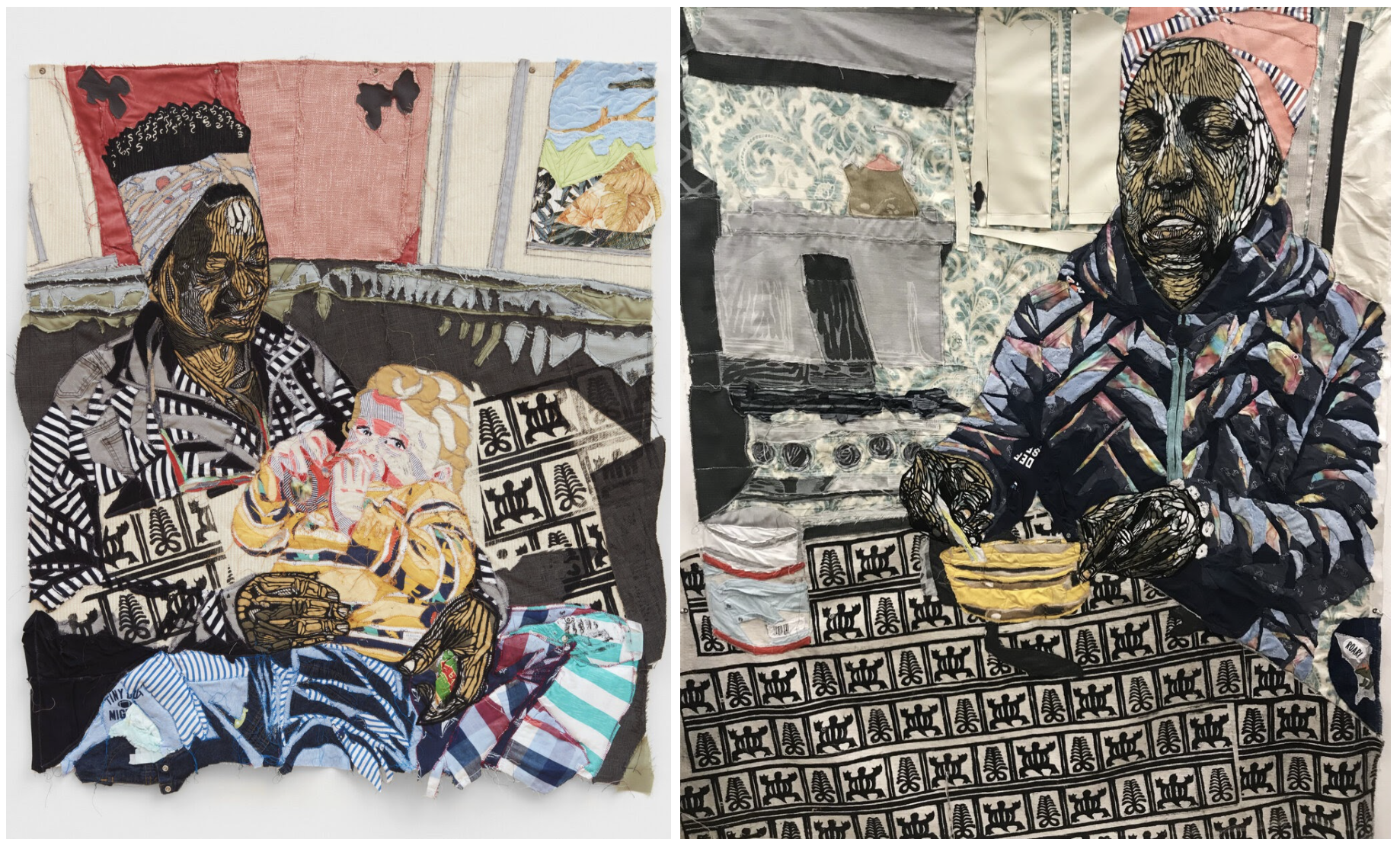
(left) Hole on man, it coming, baby clothes and relief print on fabric, 54 x 65 in., 2020.
(right) My man can eat eeh; go put dis in the gahbage, baby clothes and relief print on fabric, 2021.
I’m using folklore as the starting point to have these discussions. So, Anansi folklore are these mythical stories, if you will. Think about Brothers Grimm, but from the African version. And they’re usually storytelling animal hybrids…They’re living their life in this mystical world and the moral/model of the story is usually how to govern your life in the real world–they’re used as a point of exploring governance.
Krystle’s artwork wrestling with powerful iconography of the pre-colonial African diaspora, she continues to follow Marxist traditions of employing artwork in the critique of labor. I imagine the well-known murals of Diego Rivera, and works of early Realism in the Western canon. In the past, many movements have failed at both capitalist critique and the reconfiguration of “Primitivist” symbolism. However, Krystle’s work is apical because she does not blindly aestheticize the proletariat experience, nor the African iconography. As an artist, Krystle is employing the very craft of her own experience within its own language–working from a place where “proletariat” cannot be divorced from racial signature and ethnic identity. It is what I am most impressed by her work. I am viewing a lived experience and a lived history. I believe many artists fall short of this essential position in their production of work.
K: And so, these are the pieces I’m going to be using for the show. So I’m going to be puppeteering this piece (Tiga) . And then this one that I’m working…this one here, that’s not fired yet. Its head parts are still coming together.

installation view, BUOY, IS JUS A COMEDY AH ERRORS at Coco Hunday, 2021-2022
J: You’re using this folklore to almost construct new didactics based on you/your family’s experiences? [K: Exactly exactly exactly.] That makes a lot of sense…I don’t know if this is off topic, but I think a lot about oral traditions, oral knowledge, and storytelling. How that’s different from written stories–in the sense of subjective vs. objective experience. I wonder, do you have any thoughts on that?
K: Oh yeah, it’s so relevant. So, last year, two semesters ago I did an independent study with Dr. Elizabeth Hordge-Freeman. At that time, I was going through a lot with my family, and I started writing a whole lot. But, I found that writing in English didn’t quite cut it. Most of the things that I had to say were in broken English-Patois. And so I started trying to remember how to write in Patois. So, I started writing these stories how they would be spoken. And, that is the only way I was able to build these new narratives. These narratives that I’m now creating activity, and movement, and action for. So, from these stories I started to be able to understand certain concepts and themes; I can establish these ideas that are prevalent, from writing in my dialect, to then understand what’s taking place. So you know, just as I was getting passionate about talking to you, my dialect kind of shifts. Because my natural way of moving is through this dialect that is so ingrained in how you even gesticulate and you engage in the world; because it’s all about how you interact with the next person…
J: That’s it, so you’re saying that the dialect itself is performative? [K: Yes! It tells stories].
Understanding the application of puppeteering and the body in Krystle’s work is important. There is an intelligence living in her body; based on history, experience and culture. Her fabric work testifies to that statement, as she stitches together scraps of fabric in an application of the bodily memory of domestic labor under conditions of not having “enough” resources to work with.
“None of these materials are wholly exclusive. Why? Because we never have one or the other. We always have a little bit of each, and we just have to make do and see what can be made from it.”
K: You can say the same thing, but if you don’t say it in the right way it just don’t cut it. Jamaican Patois is about how you say what you say and how you move your body with words to tell a story. So, oral tradition is very important to Jamaicans. It is literally how we learn everything. I became passionate about labor by hearing all the stories that my father told me about working for the Jamaican Ministry of Labor. He collected stories from people about their experience in different jobs. All this information correlated into graphs that backed arguments to be brought to the government–about issues that affect people, company[‘s] productivity, but also individual health.
J: Would you consider your work as having a dance component?
K: No, not really a dance component. But, for instance, I use this stool (below). I have the puppet sit on bricks. And then I sit on a brick. It’s like being back home…Oftentimes when people tell stories [in Jamaica], they’re sitting on half of a wall that was supposed to be built years ago. And, there’s always an unfinished quality…Every yard, every person’s space, have cinder bricks from a construction project that was supposed to happen like 10 years ago that never finished. *Krystle Laughs*

Krystle’s description of these unfinished residential spaces conjures memory. There is something evocative about it in terms of my own experience. This speaks to universality in Krystle’s work. It isn’t accurate to subject this artist to classificatory categories based on race, ethnicity, gender, or social status. While the symbolic content of Krystle’s work draws upon a very specific demographic of experience, at the end of the day this artist’s work accesses a wider dialogue about the contemporary American condition in the presence of unfettered capitalism.
J: That’s so fucking funny It reminds me of my parent’s house… They gutted it one day and it’s never been finished. There was always a sheet hanging in front of the bathroom; there’s no door like this. There’s no tiles on this floor like. And it’s just like, it was always this state of like…[K: Incompleteness] what it could be.
K: That is an important point to this, because I think these bricks are at a place of possibility; and, what was. So, often people sit down and tell a story about their day. They tell what happened, but then they bring in their own part that serves as a moral of the story to teach a lesson. Some sort of proverb has to come at the end, explaining what they learned, or what was supposed to happen. So, you sit down. People sit on bricks; maybe, little stools. There’s always these little stools too. It’s like communal seating, there’s always a stool for you to catch a seat to engage with someone else. It’s their short height that creates familiarity. It makes one want to know what happened. How is your day going? What is happening with you?
So, I sit on this brick and I have the puppet in front of me, but facing away because I am thinking that I am (if we want to call it this) conjuring the energy needed to engage the puppet to react to the sound of the narration. In a way I’m playing a maternal role. I think about it this way because my mother bared kids, but she wasn’t really a mother *tskk*. She was good at doing the roles of “mothering”: feed you, clothe you, shelter you. But, not the care part. It’s understandable because she didn’t have her mother. I think about my dad and his brother. They came here to the US (and also traveled around the Caribbean) to earn money. The absence of care has always been at the cost of the dollar. Even though my mother was physically present, her brain was always focused on how she was going to make the dollar for the next day to feed us. And to give us the things that were necessary to live this full life. I am puppeteering with this idea to maternally care, through this movement and these words.
J: To maternally care for…?] Myself and the individuals that are telling their stories. We could call it in a way therapeutic; it’s like a constant re-occurring theme. [J: Like catharsis, cathartic?] Yeah. I don’t think this struggle is even isolated to just individuals that are Caribbean. I think it also is a class thing like that goes across the board. If you are coming from a place of poverty, there is a trade off where your family often trades care for the dollar. They don’t have the time to care for those around you, because that care is necessary to go try to find that dollar.
Krystle’s statements about the precedence of money over parental care ring true for me. In this moment, I feel connected with her artwork because she is sitting here telling a hard truth. Looking back, I remember many things that relate to her artwork. My mother worked more than any of my friends’ parents. Vivid memories conjured in my mind. My brother and I, the last kids at our public school aftercare. It would be almost 7 pm until my mom came to pick us up.
Although I am speaking specifically from an immigrant perspective, I know that this is a universal theme, [J: Yes it definitely is] for anyone that is coming from poverty. I didn’t even know I was poor until I grew up…We lived in our little one bedroom cottage, all four of us. Sacrifices were made for us to go to private school. My sister and I learned etiquette; the (white) engagement of how you move through spaces like you have money. Well, we didn’t have a shilling in our pocket. *Krystle Laughs* This way of acting allowed us to be able to get into the places that can bring us closer to (American) prosperity. Even being here in the University, I’ve got to code switch my ass off to get by…
J: Yeah, I remember when we first talked. We had a zoom call or something. I didn’t even realize that you’re from Jamaica… Like, you had no accent and now listen to you talk. *Krystle laughing* Now I’m like, whoa. Like you’re a code-switching master.
K: Well, I have to be. The closer you’re adjacent to popular culture (which is whiteness) the closer you get to what you want. You decide whether you’re going to code switch along your way; to not be yourself at all anymore. You just pack it up and pack it aside. Then, you have a space where you can let it go. My studio is where I can let it go. These are the things that immigrants have to go through. They have to decide what they are going to keep and what they’re going to put away because the foundation of why I do what I do is constantly in question.
There is a point to the printmaking. There is a long history of printing on fabric. In both Africa (dashikis) and Jamaica. These things are ingrained in my culture! So you’re telling me I need to choose one or the other? They all matter to me! They’re all necessary for the story! None of these materials are wholly exclusive. Why? Because we never have one or the other. We always have a little bit of each, and we just have to make do and see what can be made from it. Right now I have a few bags of clay, so I am making these sculptures. A lot of my work, when you think about material outside of the actual concept, is about coming from a place of not having enough.
J: Yeah, I see that in the…. I don’t want to say the “aesthetic” of your work. But, in your craft; taking these small pieces, stitching them together, and only using what is readily available to you. There is an intelligence behind the design that so obviously arises from experiences of not having an abundance of material goods at your disposal, as well as a resilient and resourceful attitude. This is something I think about a lot when I look at people’s art. Coming from a place of “not having” can facilitate a certain ingenuity when you entertain this desire to create within impoverished circumstances. Still, I see a lot of other white people, specifically ones from more upper-middle class backgrounds…They see poverty as an aesthetic and try to copy it. But, personally I look at their art and it doesn’t have that same intelligent design, there’s something disingenuous about it. Like, they weren’t just doing that, they were trying to do that. And there’s such a difference. *laughs*
Krystle’s art further reminds me of many types of art-making from diasporic communities of the Caribbean and South America. Making art from a location of being impoverished has political implications within its design. A political movement in early 2000s Argentina spurred the cartonera. These books of prose and poetry were made from completely recycled materials, during hard economic times. I believe Krystle’s art functions somewhat in this vein. The critique of capitalism is launched in the materials and the way that they are combined. It is unfortunate that much of my education in Art History has been focused on the European canon and the mythology of modernity. The only lexicon I have to reference comes from a solitary seminar I took with Dr. Gabriela Germana-Roquez. Krystle Lemonais’ artwork analogically reasons outside of these categories of art and history. This artist is working from a space that exists on the “borders”. Within the philosophy of Transmodernism, Enrique Dussel states that the European mythology of modernism can only be remedied by including the communities that exist in the “third spaces”; communities that exist on the “fringes” of dominant culture.
K: Very much so. There was a particular student that had a review, who often uses a lot of found materials from thrift stores. You know, taking various different items and putting them together to create sculptures. *Krystle chuckles* Someone actually said in the review: ”This stuff just looks like shit on top of shit.” *Both Laugh A lot* Boy, everybody was holding back laughter, but at the same time it’s the honest truth. It didn’t look like it was meaningfully put together. I mean, everything doesn’t necessarily need a reason that is concrete. But, art has to have a point of interest that is ingrained; something that you are pulling from to create. Even if it’s abstract. It has an essence!
Art just comes forward right. It’s supposed to bring something to life that is otherworldly. We want to contemplate it, right? But it’s something that already has to [live within you] *says together*. We as artists, we create something out of nothing. That something is coming from taking within ourselves to put in the artistic creation. If there is no transfer of that energy of actual life, you’re not making something real. It’s a figment of the imagination. You still have the same thing that you started with, the shit on top of shit.
J: That’s why I think the narrative in your work is really important.
K: Yeah, for me narrative is everything. Everything Jamaicans do starts with a story. It starts with something that already happened that you are pulling from; a story that you resonate with. You have to retell to help the next person coming after you. 
installation view (Anansi), BUOY, IS JUS A COMEDY AH ERRORS at Coco Hunday, 2021-2022
J: I don’t even know how to put this…But, what do you think about magick? Like, do you think about majik when you’re making? Does that make sense? *laughs* [K: Makes sense, it makes sense. I honestly….] There’s something very evocative about this idea of giving life to something.
K: You see, ever since I started making things, I have always felt that what I’m making is coming from somewhere else. When I’m in my studio I have to drown my brain out to make things right. I have to constantly play podcasts or music, so that my brain is not actively working. I’ll know what I’m going to do and I just let my hands do. My hands just do what they do, and they make what they make. Maybe I start with a sketch, maybe I start with an image. I keep referencing the image. But, I also trust what my hands do is right. Whenever I detour from that process, the result looks disjointed. I have had to learn to trust whatever it is. I have to create these conditions: 1. drown the brain, 2. have my sketch or image for reference, and 3. just let the hands do what they do. I don’t know how other people create their art, but I recognize that’s what I need. Because I have a very overactive brain as well, and my brain can talk me out of everything. *Laughs* I have all these stories and narratives happening. If I get lost in any of those stories or narratives, I can go on some tangents and the work will have too much happening at the same time. So, to not get tunnel driven…I have to allow my brain to work in the background, let my subconscious come forward, and move through my hands. [J: That makes sense.]
K: Yeah, I feel there’s an element of magick in that because who knows what your subconscious is really doing? Freud tried to explain it to us and we still don’t quite know what the fuck he was saying.
J: I think about your work and how you’re thinking about capitalism so much as well as labor and production. True art, from my perspective, is something that capitalism almost tells you not to do. So, it has to come from this “other”, almost illogical mindspace. Or, a space where your brain isn’t trying to be pragmatic, or practical. You know those questions that the capitalist mindset begs: “How much are you going to make from this?”, “Well, how are you going to benefit from this?” Instead, you just have to make it because you are called to make it. In my mind, I think of that like magic. In the sense of these personal rituals, that “objectively” have no practical application. The reason for them is coming from another place…
K: You know that makes sense. For instance, within the work I have rules and ethical codes for myself. So, when it comes to material, 80% of my material is always recycled. I either got it from somewhere for free, or because someone gave it to me or donated it. I go to thrift stores when I need to particularly find something that I need for a purpose. Or like I find it on the street, or in the trash. So, there is that component to the work.
I use food packaging from personal usage. [J: Oh I see some of that the avocado bag.] The ones that I have with more packaging are not here (in the studio). All the fabrics are baby clothes and upholstery fabric I get from a professor in the Art program. The only thing that is purchased is diapers for stuffing–diapers, thread, and grommets.
J: How important is it that the audience understands the narrative? You’re saying there’s a moral to the story; are you trying to communicate the moral of the story? Are you trying to figure out these stories yourself, or are you trying to figure them out for yourself?
K: It’s more for myself to figure out the stories. I want the viewer to see what they understand from the story, and figure out their own moral. There are symbols, ways of using iconography, and composition that tell specific things. Those symbols are encoded in the work itself. If there are choices about what is happening in the work; if they are looking at them all together, they can see recurring themes. In addition, when one looks at the title, then they look at the materials–they can start to see that a lot of the materials are recycled. The title is not completely English and viewers have to constantly work to decode what is taking place. There’s some research, or engagement, that has to be done to find out what is happening…
I feel like the viewer is constantly implicated by the composition and finding themselves in the work. However, I’m pulling from a place of personal experience. I’m also engaged in my overall narrative; not only those of domestic work, nor these relationships of my father, his brother, my sister, and myself. It’s these universal relationships that happen when one is choosing to buy into capitalism and try to upwardly become mobile. There’s just things that are constant…Tears and fragments in relationships…Values shift…
How do you decide to engage with your neighbor?

Tiga an Anansi reason cross de fence, BUOY, IS JUS A COMEDY AH ERRORS at Coco Hunday, 2021-2022
J: When you are saying capitalism, along with this idea of acculturating. What is the relationship between capitalism and whiteness? Do you think of them as almost the same entity? You know what I’m saying?
K: Absolutely. I was a nanny just like my mom. When I got out of high school. Our papers hadn’t been adjusted yet. It took a long time for that to happen. I got this interview for a job and most of the engagement was done via email until I had the interview. Two years after I had the job and built a rapport with these people, one of the neighbors was telling me: “Oh, you know when Jess was going to interview and she saw you in person…she didn’t see you as a ‘Krystle.’” They probably thought I was white. Like the way she was explaining, is that they thought I was white. It’s funny because I’ve known since I was a kid that my name was chosen with this spelling because it’s from England; it sounds like a white name. You would never know on paper if I was black or if I was white. *Laughs* All these compromises to be adjacent to whiteness, has constantly been a loss for both white and black people.
J: Yes! I think about that all the time. [K: And that is a lot of what I’m thinking about in my work as well.] There’s something stolen; whiteness takes from everybody… [K: Everybody, everyone is losing.] And leave a void. A white void.
K: I feel like all we can do is talk about our experiences. You know, up to the point where you’re at, and what you think there is potential for in the future. That is all we can do. Anything more? We either can’t think of it yet, because we don’t have the necessary experience to get us there. Or, it just doesn’t exist yet. We need to reflect on the past with what we’re experiencing now… And then think of what can possibly come from this point forward, to get to the next point. Someone else will always come to take the baton and do something more.
When people talk about decolonizing anything that is what comes to my mind. To me, we can only work from the point that we’re fuckin on. [J: Within history, but also like where you’re located, like within yourself.] Exactly exactly. Anything more or less to me I find disingenuous because…like, who gives you the right to also discuss things that are not within your actual parameter of your experience?? [J: Like stay in your lane..].
Yeah, it’s like just fuckin stay in your lane. But there’s enough within your little in your parameter to deal with! There’s enough right there. If you just focus on right there. Everybody needs to focus on their everyday little spaces. It could change things if everybody just focused right there.
J: So, that’s your reasoning for using these personal histories? [K: Yeah, just focus right there.] That makes sense, that makes a lot of sense.
K: The way capitalism is structured, it makes you think you don’t have the capability to just do what is right here. It undermines your worth or the value of your story. ‘Cause who would think that the stories of my father and my father’s brother would be relevant right now?
J: Yes, capitalism almost wants to erase those…Obviously like, they can’t make money off of it. Our stories are completely divorced from the value of our labor. We are just a workforce. [K: And, everybody has a relevant story.] Yeah, I think about that a lot. Especially, when I talk to other white people and they don’t think that their family history is important. Or, they automatically just write it off and be like, “Oh but I’m just white”. And I’m like, “OK, but there’s still…you still have 16 great grandparents! You still have like all these people, and each one has a story.”
For further reading on Marxist Theory.
K: So rich it’s so rich!
J: There’s so much to find out. [K: And, white people’s life has been documented so fuckin well.] Riiight? [K: *laughing* Got a lot to start from right there!] My dad’s family, I’ve traced their lineage back to the 1600s because there was a book online. They were some type of Protestant Reformers, who settled in the Delaware Valley—Pennsylvania Dutch. So, they kept track of everyone that was married and everyone that was born within the church…It’s all written all down in this book that’s right online.
K: Wow yeah, that is fascinating! On my dad’s side, I’ve been able to trace back until the 1800s? My last name is of a white man that came to Jamaica as a general from the Prussian army, and he was a medic. And he was awarded land, 300 acres in the countryside of Jamaica. He had bought slaves to workthe land. When Jamaica was becoming free (c. 1840), they became indentured servants. [J: Ah, sharecropping.] Yeah, sharecropping.
To this day that land is still there, as are names of people in my family. Albert Lemonias was my dad’s grandfather. He remembers leaving that land to go to World War One.
J: Whoa, that’s cool. I have a friend from Providence, he has done a lot of work with black ancestry. Their family is from North Carolina.
But, a somewhat similar narrative where; there’s land that his family has owned through generations, and they were sharecroppers on it. They still own that land; still got relatives there.
K: I decided to not do ancestry research because I value the oral story. I’ve only taken stories from my family, and I use other family members to corroborate. I know this story is accurate because my dad told me that in the Jamaican Archive there is a description of Lemonias getting 300 acres of land. I was able to see it online. That’s the only thing I know that is fact. Everything else stories of people that lived on the land, left the land and came to town, or had family that passed through the land at some point.
J: That’s interesting, to solely rely on oral tradition. I’ve also found out a lot just by asking questions to my relatives. But, there’s also things that I only found out by going through the ancestry archives. However, the things that I’ve been told by relatives are more real. They are the things that would never be archived. I think about that; how historical archives don’t have that subjective component. You would never know how someone felt about something, or many nuances in dialogue and human interactions surrounding an experience. I feel like you can only get by talking to people and asking questions. (The archives) It’s mostly marriage, divorce records, and census. You don’t really find much. A lot of the questions that I have can’t be answered.
K: What I probably have to do is go back to that land and talk to people living there. That is a trip that I’ve been planning with my dad. As for now, before I do that, I want to make this work from this place of limitation. Limitation is what makes me thrive. As long as I remember making things I’ve made the best things of when I didn’t have enough. I take that knowledge as law. With material limitations in what I have access to, I have to make do with what I can. Now I’ve realized that there are speed bumps. For instance, recently my mom we’ve been having a very rocky relationship since I left Jersey two years ago to come here for grad school…Recently this summer, she told me to stop using her in all my artwork. *Mocking* “Stop, stop using my face…stop.” She sent me a written document to note, [J: Oh my God!] “I’ve told you to stop doing this.”
J: I mean automatically where my brain goes…is, “That’s so fucking capitalist!” and also so funny. I would probably turn around and use the document in another artwork…[K:Exactly!!] Oh my gosh, my brain just went full circle thinking about your work now. ‘Cause you’re saying that your family immigrated here, and there’s this pressure to buy into capitalism. But, it has directly affected your being, and ability to get care from your mom. She’s become a certain type of way, because of her need to buy into capitalism. I think it’s such an effective way to understand things; the implications of these broader ideas or histories on your person.
K: Yeah, exactly exactly. We constantly engage in things in society because it affects us, parts of our experience makes us want to mix into it, like get into it and know more. There is that component of the work. But, going back to these puppets. These puppets are more this engagement with my father and what I have learned from him. But, then what he has lost. In Jamaica, he worked for the government in the Ministry of Labor, adjacent to Department of Labor in America. In this position he essentially was looked at as doing very well in society. In Jamaica if you work for the government, you have health insurance and all the perks of what you would have here. But Jamaica, of course, is a smaller nation so your pay does not reflect this “status quo.” So, you move and you walk the part of someone that has status in society, but your pocket does not reflect. But, at the same time it allows you to access a visa; a ticket to freedom, right? */sarcastic/*
You can make it look like you’re never leaving. My mom worked at the bank *chuckles*. To leave the nation, or to get a visa, you have to look like you’re never going to leave Jamaica. You have to have assets; you have to have something to look like you have a firm footing. [J: Oh, I see. Yeah, because they don’t want you to come here (America) and stay here.] Right. Even if you have a reason to visit, or travel or so forth, it’s usually never the reason that you want to leave the place. My dad left because his life was threatened…As someone that was working in politics, you end up having to choose a side. In Jamaica, it is whether you’re a PNP, which is the People’s National Party. And JOP, I forget what the other one is. But, it’s essentially like democratic and republican. Socialism is mixed in on one side. It’s a little different, not as strict as America, you know?
I don’t know how to explain it. I haven’t engaged in Jamaican politics as much as my dad has. Anyways, he was on one side and his life was threatened by the other side. That made him have to leave. So, my mom, my sister, and I lived in the Caribbean with one income. My dad, being a person who always pushed papers, came here and worked in construction! *Laughing* Woahh! What a shift in life.
[J: So going from this white collar to blue collar life, that’s funny.]
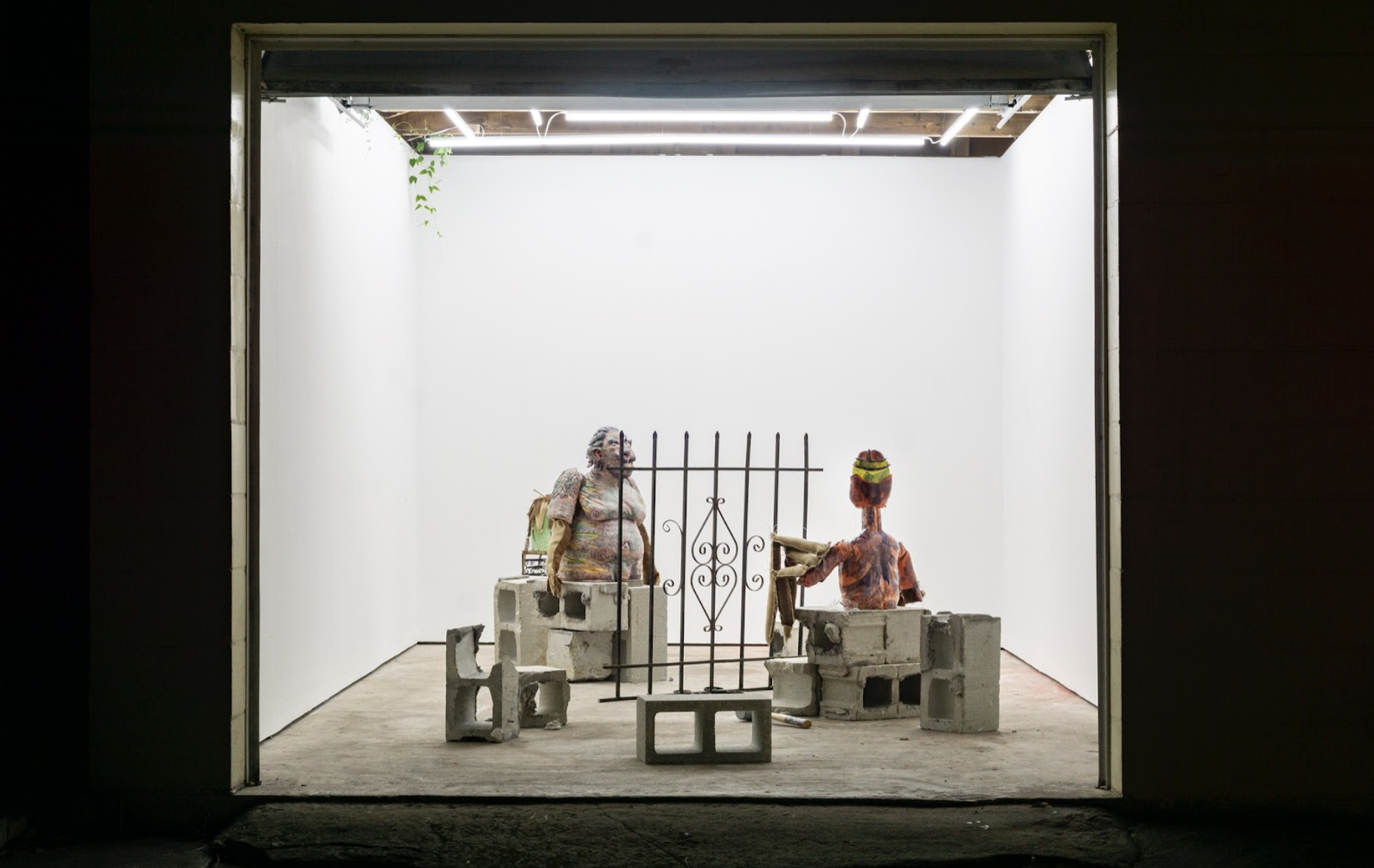 BUOY, IS JUS A COMEDY AH ERRORS, Coco Hunday, 2021-2022
BUOY, IS JUS A COMEDY AH ERRORS, Coco Hunday, 2021-2022
He has never recovered. [J: It was like a blow to like his…] Fucking blow to his whole system, that he has never recovered. He’s been scraping to get to that place, this identity he had in Jamaica. But, with the income of America he never had the opportunity to be able to go to school here to transfer that knowledge and that know-how that he had in Jamaica into American Society. Because when we even came here, we had to wait so long to get our papers…
Viewing Krystle’s in the Coco Hunday space gives an interesting aural experience. The ceramic puppets make a scraping noise that is evocative of manual labor. It sounds like construction work as the puppets sit atop cinder bricks. Divided by a wrought iron gate. The sound of her father’s voice resonates in the background, bouncing off the concrete floor and the fresh drywall of the gallery. It reverberates. Puppeteering, the artist engages her creation in repetitive motions. Back and forth, the head moves. Up and down, the arms move. I am reminded of factory work, folding boxes for hours in the fluorescent lighting of a massive warehouse.
#